![]()
![]()
![]()
Use LEFT and RIGHT arrow keys to navigate between flashcards;
Use UP and DOWN arrow keys to flip the card;
H to show hint;
A reads text to speech;
35 Cards in this Set
- Front
- Back
- 3rd side (hint)
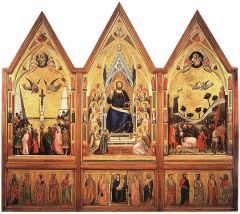
|
"Stefaneschi Triptych Altar Piece" |
Why is it important?
Commissioned by Cardinal Giacomo Stefaneschi Depicts how the size of a figure determines its importance. Isocephalic – having all the heads of the figures at the same level, typical of Medieval style. Right side shows Peter being hung upside down. Center shows Christ the king (bigger than everyone else). Left side shows Paul being beheaded. Center panels depict the perfect world. Side panels depict the natural world. Leaning towards Renaissance, or the focus on the real world |
|
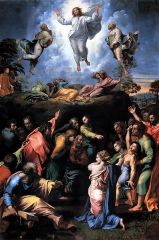
|
"The Transfiguration of Christ" |
Why is it important?
Commissioned by Cardinal Giulio de Medici, later Pope Clement VII. The painting is propagandistic, meant to depict that Christ was divine on earth no matter what Luther says. Apostles below trying to perform a miracle. Two men on the left show vintage Da Vinci qualities. Small muscular boy in front show classic Michelangelo traits. Raphael is inventive through combining messages to tell a story. Raphael shows order by structuring his art for the eye. Raphael depicts richness and beauty through the tactile and “perfect” quality. All key characteristics of Raphael and high renaissance art. |
|

|
"Laocoön and His Sons"
Artist: three Greek sculptors Date: 1st century B.C. Original Location: Ancient Greece Current Location: the Vatican Style: |
Attributed by Pliny the Elder.
Message: no matter who you are, you can’t defeat the gods. Michelangelo helped find the statue. |
|

|
Stanza della Segnature
Artist: Raphael Date: 1508 - 1511 Original Location: personal library of Julius II Current Location: the Vatican Style: Renaissance |
Where all the papal edicts were signed.
Julius II was known as “Terribilità,” which means spirited, terrible, irascible, unwilling to bow to anyone’s genius but own. Walls represent poetry, religion/theology, law, philosophy – the four bodies of knowledge. Sense of grace and effortlessness in Raphael’s art. |
|
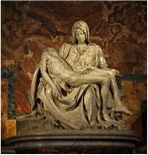
|
"Pietá"
Artist: Michelangelo Date: 1498 Original Location: Old. St. Peter’s Basilica Current Location: St. Peter’s Basilica Style: Renaissance |
Commissioned by a French cardinal.
Altar piece dedicated to the Virgin Mary. Became Michelangelo’s calling card. His only signed piece. Dead Christ on his mother’s lap. Visual image of “transformation” – bread, blood, body of Christ. Mary = church, Christ = salvation. |
|

Sistine Chapel - North Wall
|
Scenes of the life and times of Jesus, the Christ (anointed). Such as "The Sermon on the Mount" by Rosselli and "The Baptism of Jesus" by Perugino.
|
Age of Grace
|
|

Sistine Chapel - North Wall
|
Frescoes in between windows: Pre-Constantinian sainted popes
|
|
|

Sistine Chapel - South Wall
|
The stories behind Moses, such as "The Ten Commandments" by Rosselli and "Moses’ Journey through Egypt" by Perugino.
|
Age of Law
|
|

Sistine Chapel Ceiling
|
9 Scenes from Genesis (R to L):
1-3: Creation of Matter by God 4-6: Creation of Man 7-9: Story of Noah |
|
|

Sistine Chapel - Ceiling
|
Spandrels and Lunettes: Ancestors of Christ
|
List of names that begins with the Gospel of Matthew, the generations linking Christ with the tribe of David.
|
|

Sistine Chapel - Ceiling
|
Quattrocento frescoes: Hebrew Prophets and pagan Sibyls who foresaw the coming of the Messiah
|
|
|

Sistine Chapel - Ceiling
|
Double Corner Spandrels (Pendentives): Scenes of Old Testament Salvation -
Entrance (Tyrannicides): 1. David killing Goliath 2. Judith and Holofernes Other end: 3. The Death of Haman 4. Moses and the Serpent of Brass |
|
|

Sistine Chapel - Ceiling
|
Entrance: Prophet Zachariah - prophesied Christ as branch/tree and symbolic entry into Jerusalem
Other end: Prophet Jonah - belly of the fish - symbolizing Christ's burial and resurrection |
|
|
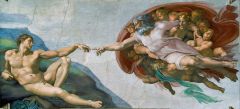
|
Creation of Adam
Sistine Chapel |
Much more painterly, than sculpturally. Physical to spiritual movement. Heavy emphasis on figural form. Perfection. Man is living, breathing image of God.
Adam, first Christ. Eve, First Mary. |
|
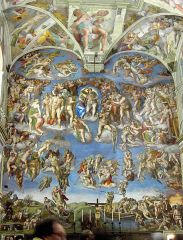
Sistine Chapel - East Wall
|
"The Last Judgement"
c. 1535-1541 After the Sack of Rome. Depicts the second coming of Christ and the Apocalypse. |
|
|
|
Buon (True) Fresco
|
Watercolor painted onto newly applied, damp plaster.
|
Michelangelo transferred his designs for the Sistine Chapel to the wet plaster by holding it up and following the lines with a stylus, making grooves that can still be seen.
|
|
|
A Secco Fresco
|
Watercolor painted onto dry plaster
|
Michelangelo used this technique to retouch the Sistine Chapel ceiling after it's completion.
|
|
|
Sistine Chapel
|
Artist: Michelangelo
Date: 1508-1512 Location: Vatican City |
THEME: Redemption
Completed in Thirds: payments, scaffolding, painting. |
|
|
Michelangelo's assistants for Sistine Chapel
|
Perugino
Signorelli Botticello |
|
|
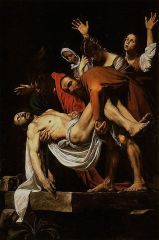
|
"The Entombment of Christ"
Artist: Caravaggio Date: 1602-1603 Current Location: the Vatican Style: Late Renaissance (borderline Baroque) |
Why is it important?
Most important artist to embody shift from Renaissance to Baroque. Connects with the viewer formally and emotionally. The ambiguity of the narrative creates multiple narratives. |
|
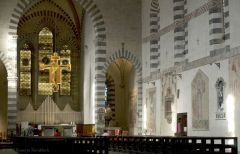
|
Colors of stripes on arches representative of Dominican habits.
White - purity Green - hope Red - faith B&W - Islamic Aesthetic |
Dominican habits
|
|
|
1453
|
Constantinople Falls
|
Battle scenes depict the world of the militant Franciscan.
Eastern influence of the time – ideas, texts, fashion. War is in the air through the 1450s. “Saving the Holy Land”: Franciscan priest jumps in a suit of armor and joins the fight in 1456; Shows the militant nature of Franciscans. |
|
|
The Forum (def'n)
|
Intersection of the Decumanus and Cardo.
|
Central point of commerce and philosophy in town.
|
|
|
Renaissance (Def'n)
|
"Rebirth"
Of Ancient Rome |
|
|
|
Qualities of the Renaissance
|
1. Importance of Classical Rome
2. Importance of the Individual 3. Importance of a Common Language/Vernacular - Italian |
|
|
|
Uffizi
|
"Offices"
Built by Giorgio Vasari from 1565-1570, who was considered the first art historian. Used to be connected to the town hall. |
Wrote "The Lives of the Various Illustrious Artists," which is responsible for how we understand the progression of the Tuscan Renaissance. Viewpoint = anything after the 3 Greats are just wannabes.
|
|
|
The 3 Greats
|
Michelangelo
Rafael Leonardo |
Donatello was later, the 4th, but runner up for title "Great"
|
|
|
One-Point Linear Perspective
|
The use of a single vanishing point
with the combination of horizontal and vertical lines (orthogonal and transversals) which recede into background at vanishing point. |
|
|
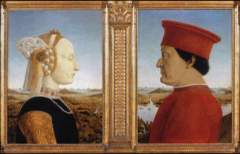
|
"Duke and Duchess of Urbino"
Artist: Piero della Francesca Date: 1472-1475 Original Location: Duke of Urbino’s studio Current Location: Uffizi Style: Renaissance |
Duke creates the town and earns all of his money by being
a “condottieri,” or mercenary. He is the most important mercenary of the 15th century. His profile depicts ancient Roman coinage. Emphasis on man and his essence. Captures him as an individual, rather than a “perfect” beauty. Duchess is not that identifiable, looks like a typical woman with no definable features. |
|

|
"Birth of Venus"
Artist: Botticelli Date: 1484 Original Location: temporary canvas, for wedding Current Location: Uffizi Style: Renaissance |
Introduces a new aspect of Renaissance; emphasis
on education, importance of intellect. Neo-platonic tradition; a new emphasis on Plato and Aristotle. Duality of two worlds – the perfect world and the imperfect world. 1. Right side: world of man represented by “time,” 2. Left side: world of the gods represented by the god of wind, 3. Middle: Venus, the embodiment of beauty. |
|
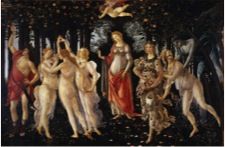
|
"Primavera"
Artist: Botticelli Date: 1480s Original Location: outside nuptial chamber, for wedding Current Location: Uffizi Style: Renaissance |
Oil painting on panel, not meant to be seen.
Otherworldly; depicts the seasons: March: Zephyr, god of wind April: Clora, Zephyr’s concubine May: Flora Mercury on left Venus in center: bride to be |
|
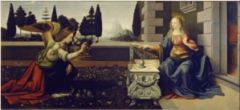
|
"Annunciation"
Artist: Leonardo da Vinci Date: 1473 Current Location: Uffizi Style: Renaissance |
Early Da Vinci. Imperfections.
Emphasis on the natural world. ATMOSPHERIC PERSPECTIVE – sky lightens as it distances from foreground. 1. Foreground: very depicted colors and true lines 2. Midground: turns green with less defined lines 3. Background: emphasis on blue and has a misty quality One-point perspective ends in the center of the painting. Da Vinci’s only attempt at one-point-linear perspective. |
|
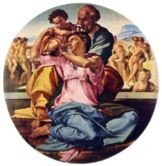
|
"Doni Tondo"
Artist: Michelangelo Date: 1507 Original Location: gift for new mother Current Location: Uffizi Style: Renaissance |
Only panel painting by Michelangelo.
The date is a “mystery” however, as well as the story of the pigment Foreground: Mary, Joseph, and Jesus; holy family. Mid ground: John the Baptist and nudes. Background: landscape and atmospheric perspective. |
|
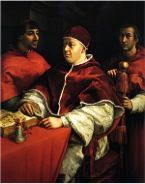
|
Leo X
Artist: Rafael Date: 1518 Current Location: Uffizi Style: Renaissance |
Show’s Raphael’s true artistry.
First Medici pope. Seems dislocated with reality; three figures who don’t seem to be communicating. Symbolizes Roman disconnect. Raphael seems to know things are awkward and will eventually change. Beauty of Raphael is in his portraiture. |
|
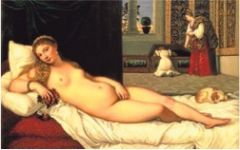
|
"Venus of Urbino"
Artist: Titian Date: 1538 Original Location: Studio, covered up Current Location: Uffizi Style: Renaissance |
Commissioned by the great-grandson of the Duke of Urbino, Guidobaldo II della Rovere.
Used to be known as "The Courtesan" Epitome of a man’s perspective of beauty in the 16th century. Sfumato: smoky, Da Vinci-esque; o Dainty feet o Smaller breasts o Reddened knees o Thighs larger o Womb in center of painting − Depiction of wealth: o Country view means a second home o Wedding chests - "cassone" o Maids o Dog - fidelity o Tapestries |

